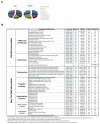Identification of a novel zinc metalloprotease through a global analysis of Clostridium difficile extracellular proteins
- PMID: 24303041
- PMCID: PMC3841139
- DOI: 10.1371/journal.pone.0081306
Identification of a novel zinc metalloprotease through a global analysis of Clostridium difficile extracellular proteins
Abstract
Clostridium difficile is a major cause of infectious diarrhea worldwide. Although the cell surface proteins are recognized to be important in clostridial pathogenesis, biological functions of only a few are known. Also, apart from the toxins, proteins exported by C. difficile into the extracellular milieu have been poorly studied. In order to identify novel extracellular factors of C. difficile, we analyzed bacterial culture supernatants prepared from clinical isolates, 630 and R20291, using liquid chromatography-tandem mass spectrometry. The majority of the proteins identified were non-canonical extracellular proteins. These could be largely classified into proteins associated to the cell wall (including CWPs and extracellular hydrolases), transporters and flagellar proteins. Seven unknown hypothetical proteins were also identified. One of these proteins, CD630_28300, shared sequence similarity with the anthrax lethal factor, a known zinc metallopeptidase. We demonstrated that CD630_28300 (named Zmp1) binds zinc and is able to cleave fibronectin and fibrinogen in vitro in a zinc-dependent manner. Using site-directed mutagenesis, we identified residues important in zinc binding and enzymatic activity. Furthermore, we demonstrated that Zmp1 destabilizes the fibronectin network produced by human fibroblasts. Thus, by analyzing the exoproteome of C. difficile, we identified a novel extracellular metalloprotease that may be important in key steps of clostridial pathogenesis.
Conflict of interest statement
Figures





References
Publication types
MeSH terms
Substances
LinkOut - more resources
Full Text Sources
Other Literature Sources
Molecular Biology Databases

